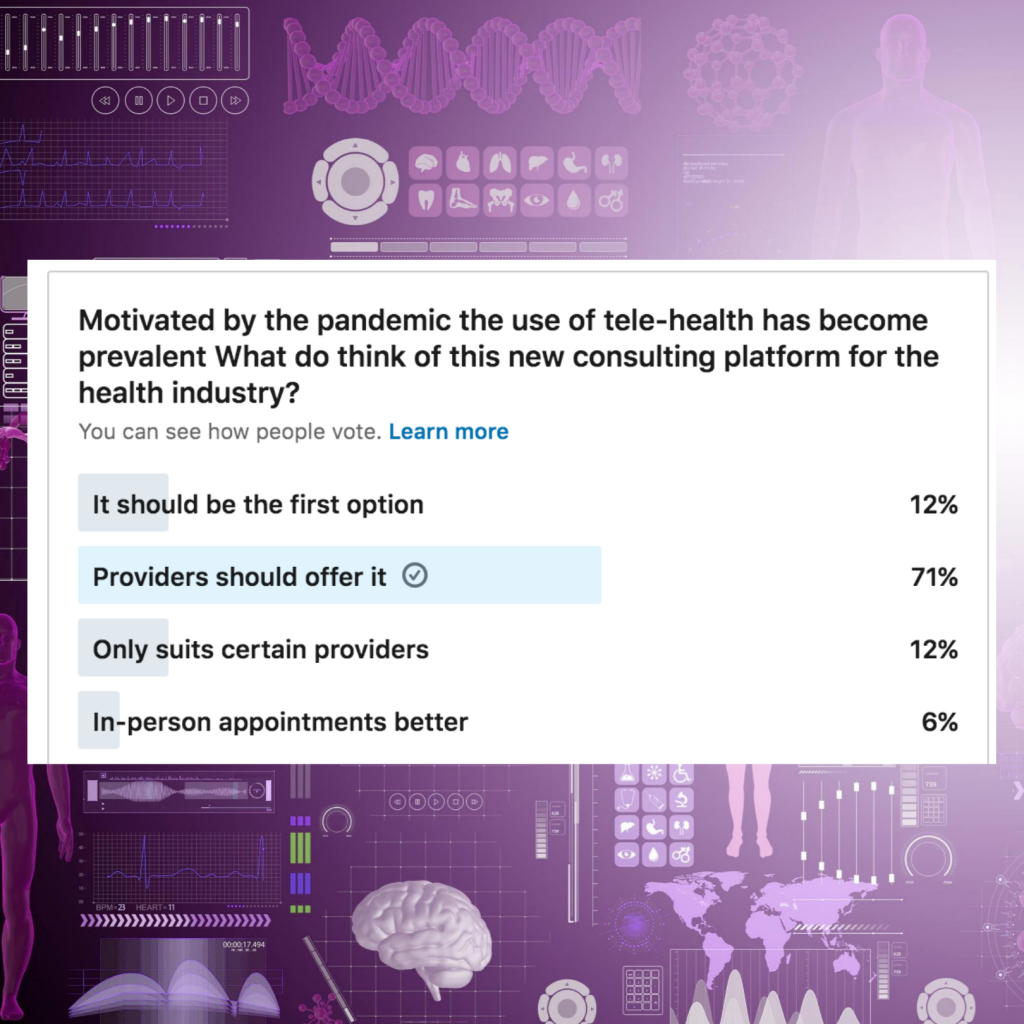Recently Purple Giraffe undertook the above poll on our LinkedIn page, asking for thoughts on telehealth, both as a concept and its application in today’s pandemic affected world. The results were resounding.
Of those who responded, an overwhelming 71% declared that health care providers should offer telehealth as an alternative in their patient care regime, and 12% indicated that it should be a first-choice option. On the flip side, 12% indicated that they feel it has its limitations and only suits certain service providers and a small percentage (6%) still feel that in-person appointments are the best way to provide health care.
In this blog, we will look at telehealth, its recent rise, and its potential future in a world that is increasingly difficult to plan forward in.
The pandemic – a catalyst for change
As the impacts of the COVID-19 pandemic continue to ripple across the globe causing deep uncertainty and a new social behaviour etiquette, one thing is certain, the world, and the way we live in it has changed forever. However, looking at the positives, change can be a good thing and can bring benefits.
Industries, businesses, services, and products have had to pivot in response. Essential services, including health providers, were forced to adapt. The rise of the use of telehealth was rapid, necessary, and effective, and so far, has been a benefit of this change.
It was already coming in an industry that can be resistant to change
The truth is that telehealth was around before the pandemic, but it was not mainstream and only used by progressive providers, or in circumstances where it was unavoidable. In Australia, most health care providers were not using it. The national lockdown changed all this, and health providers on mass signed up to video conferencing and online scheduling tools to facilitate this offering. Across the board health professionals from regular GP’s, physios, psychiatrists, through to specialist providers like brain surgeons all began consulting online very successfully. Obviously, surgery was and remains not possible via this format but much else is, and the result was that people at home were able to access the care and treatment that they desperately needed in a time that was fraught with stress and anxiety. This is reflected in the poll results.
Now that health care providers, and us as the population, have been forced into adopting this new way of accessing health professionals, let’s look at what this means for the industry, and for us as users of it, moving forward.
The benefits of this new format
The good news is that there are many benefits to this new service format, for both the providers and the receivers. Even better – the good parts of the old system do not have to be forgotten either. Accessing health care can now evolve as a choice-based hybrid.
The benefits are:
Flexibility
In today’s busy, and increasingly unpredictable, world it is always beneficial to have the flexibility of choice as a consumer of services. Being able to access and attend an appointment with your GP while at home, on a work break, during unusual hours, or even while travelling, is hugely beneficial, and modern-day technology makes this seamless.
For the health provider, this format also allows them to work from various locations, and during hours that suit both them and their clients. It also allows these businesses and professionals to continue to provide these services through times of crisis, like a pandemic.
Efficiency
Time is saved for both parties. Travel and wait times are reduced, if not completely eliminated, for the patient.
Providers can effectively attend to patients without keeping them waiting, avoiding frustration, and full waiting rooms. Other benefits, like streamlined paperwork and booking systems, can become business norms.
Reducing health risks
Appointments via telehealth ensure the safety of the provider is maintained as they do not come into contact with potentially ill and infectious patients. In addition to this, the patient is not exposed to full and potentially infectious crowded doctors waiting rooms. If an injury makes it hard to travel or be mobile for the patient, again this format is a very useful means of attending a follow-up or emergency appointment.
However, it is worth noting here that some diagnosis processes and consults do require the person to person contact and testing. In these instances, the risks of missing something or of not providing an effective and complete diagnosis is real. This is where telehealth experiences its limitations and where in-person consultations are necessary.
Cost
The cost for both the patient and the provider can be reduced.
For the patient, this can be measured in terms of the cost of the actual appointment, which may be reduced due to the different format, as well the actual cost of getting there (travel, time, parking, missing work time).
For the provider, having fewer people in waiting rooms, needing to provide fewer consulting rooms, and losing less time between appointments can reduce overheads and improve efficiency.
Proximity
Tele-health is not location dependant. Therefore, a patient can access their provider no matter where they are.
In house consultations should remain available too
The good news is that even though telehealth is now a very accessible option, if you need to physically see a health care provider, or if this is your preference, you are still able to use this option. The rise of telehealth has not seen in-house consultations disappear, and due to the nature of health services, a level of contact and in-house patient care will always be available.
What does the future look like?
Now that it’s been thrust upon this service industry, and a large portion of the population has used it with success, telehealth is here to stay.
Its benefits are just too real, and make too much sense in this new normal, to ever revert back to the previous status quo.
As the years go by it is likely that the use of telehealth will be become more prolific – certainly for providers that this type of care is suited to.
However, in house consultations will always remain a fixture in health care as sometimes people need that contact. And let’s face it, for humans to stay well and connected it’s important to occasionally have that personal contact every now and again no matter how new age we get.







